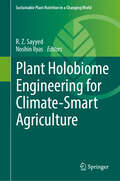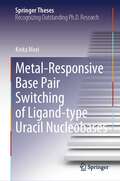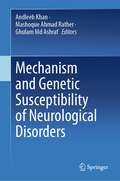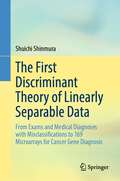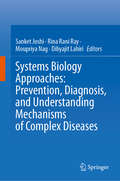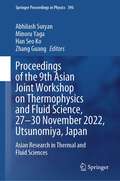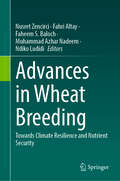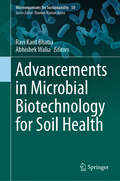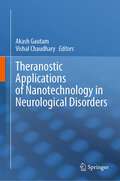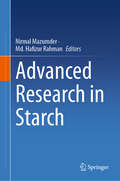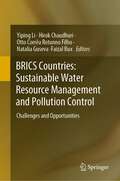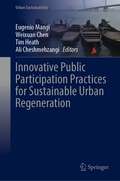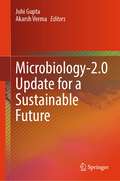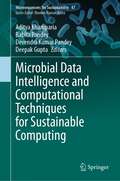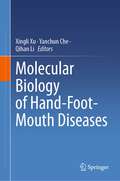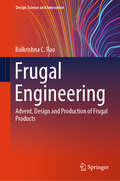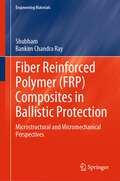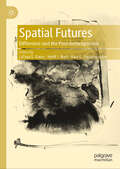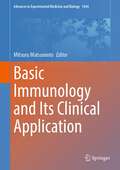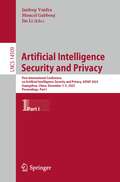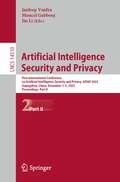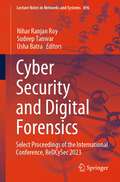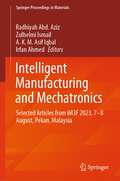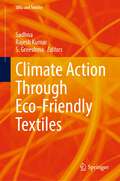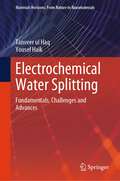- Table View
- List View
Plant Holobiome Engineering for Climate-Smart Agriculture (Sustainable Plant Nutrition in a Changing World)
by R. Z. Sayyed Noshin IlyasThis edited volume is an inclusive collection of information on crop holobiome, their function and diversity, the plausible role of soil microbes in crop growth, protection from pathogens and stresses, the use of resilient microbiomes for changing climate, and the use of new technologies to study plant-insect-microbe molecular interactions in agricultural systems. Holobiomes provide information about both plants and their microbiomes, which gives a more comprehensive insight, particularly for changing climatic scenarios. By optimizing the crop holobime function crop productivity and plant health can be enhanced manifold. This book deep dives into the numerous ways in which holobiome supports the improving plant health, nutrient uptake, disease control, and stress resistance in major food crops. It helps researchers, academicians, agri-entrepreneurs, and technologists understand the structure and function of holobiomes in crop growth, health, stress tolerance under climatic changes, and holobiome diversity and evolution. The book is also helpful in designing new dimensions in the holobiome research and development of new products and technologies. This volume is of interest and useful to agriculture scientists, microbiologists, ecologists, and is a valuable source of reference to researchers and students.
Metal-Responsive Base Pair Switching of Ligand-type Uracil Nucleobases (Springer Theses)
by Keita MoriIn this thesis, the author proposes "metal-responsive base pair switching" of ligand-modified nucleobases as a novel tool for stimuli-responsive control of DNA assemblies. It is written to demonstrate broad applicability of the base pair switching in dynamic DNA nanotechnology and inspire researchers to use this technique. Based on specific interactions between ligand-type nucleobases and target metal ions, in this volume, DNA hybridization was dynamically controlled through strand displacement reactions. The base pair switching was further applied to develop metal-dependent DNA molecular machines. This novel strategy for stimuli-responsive regulation of DNA assemblies will greatly expand the scope of dynamic DNA nanotechnology. This volume uniquely features importance of elaborate molecular design based on chemistry for imparting stimuli responsiveness to DNA assemblies.
Mechanism and Genetic Susceptibility of Neurological Disorders
by Andleeb Khan Mashoque Ahmad Rather Ghulam Md AshrafThis book is about the "Mechanism and Genetic susceptibility of Neurological disorders. It is a comprehensive exploration, penned by esteemed authors, and offers a profound understanding of these enigmatic ailments, their progression, and the strategic approaches employed to mitigate their impact. In this book, readers will uncover a wealth of knowledge surrounding the mechanistic intricacies that underlie various neurological disorders. Through meticulous research and insightful analysis, the authors elucidate the inner workings of these conditions, shedding light on the mechanisms responsible for their onset and progression. The central themes of this book are the recognition of the genetic landscape governing neurological disorders. It emphasizes the role played by a diverse array of genes in the development and progression of these conditions, highlighting the multifaceted genetic susceptibility that underlies their manifestation.
The First Discriminant Theory of Linearly Separable Data: From Exams and Medical Diagnoses with Misclassifications to 169 Microarrays for Cancer Gene Diagnosis
by Shuichi ShinmuraThis book deals with the first discriminant theory of linearly separable data (LSD), Theory3, based on the four ordinary LSD of Theory1 and 169 microarrays (LSD) of Theory2. Furthermore, you can quickly analyze the medical data with the misclassified patients which is the true purpose of diagnoses. Author developed RIP (Optimal-linear discriminant function finding the combinatorial optimal solution) as Theory1 in decades ago, that found the minimum misclassifications. RIP discriminated 63 (=26−1) models of Swiss banknote (200*6) and found the minimum LSD: basic gene set (BGS). In Theory2, RIP discriminated Shipp microarray (77*7129) which was LSD and had only 32 nonzero coefficients (first Small Matryoshka; SM1). Because RIP discriminated another 7,097 genes and found SM2, the author developed the Matryoshka feature selection Method 2 (Program 3), that splits microarray into many SMs. Program4 can split microarray into many BGSs. Then, the wide columnLSD (Revolution-0), such as microarray (n Theory3 shows the surprising results of six ordinary data re-analyzed by Theory1 and Theory2 knowledge. Essence of Theory3 is described by using cephalopelvic disproportion (CPD) data. RIP discriminates CPD data (240*19) and finds two misclassifications unique for cesarean and natural-born groups. CPD238 omitting two patients becomes LSD, which is the first case selection method. Program4 finds BGS (14 vars.) the only variable selection method for Theory3. 32 (=25) models, including BGS, become LSD among (219−1) models. Because Program2 confirms BGS has the minimum average error rate, BGS is the most compact and best model satisfying Occam’s Razor. With this book, physicians obtain complete diagnostic results for disease, and engineers can become a true data scientist, by obtaining integral knowledge ofstatistics and mathematical programming with simple programs.
Systems Biology Approaches: Prevention, Diagnosis, and Understanding Mechanisms of Complex Diseases
by Sanket Joshi Rina Rani Ray Moupriya Nag Dibyajit LahiriThis book examines the development and applications of system biology approaches for the prevention, diagnosis, and understanding of disease mechanisms. It explores the applications of system biology in infectious diseases, including host-pathogen interaction, and the identification of targets for new therapeutics and intervention strategies. It covers the use of system biology for understanding and treating metabolic disorders towards personalized and precision medicine. The book further discusses the systems biology approaches for understanding the mechanisms of tumor progression and designing more effective cancer therapies. The chapter also reviews the current strategies in autoimmune disease treatment and highlights the opportunity that systems biology represents for the development of better and safer treatments. Importantly, the book discusses the current state of the systems-level understanding of diseases and both the therapeutic and adverse mechanisms of drug actions usingsystem biology approaches. Cutting across the disciplines, this book is a valuable source for researchers in genetics, molecular biology, cell biology, microbiology, and biomedical sciences.
Proceedings of the 9th Asian Joint Workshop on Thermophysics and Fluid Science, 27–30 November 2022, Utsunomiya, Japan: Asian Research in Thermal and Fluid Sciences (Springer Proceedings in Physics #396)
by Abhilash Suryan Minoru Yaga Han Seo Ko Zhang GuangThis book is a collection of the best peer-reviewed papers presented at the ninth Asian joint workshop on thermophysics and fluid science organized in Utsunomiya, Japan, in November 2022. The book is a valuable addition to the conference series started in the year 2006, with contents that include the research outputs from Asian countries—India, China, Japan, and the Republic of Korea. Some of the papers are collaborative efforts by academicians from these countries. The book provides an overview of recent research in the fields of fluid and thermal engineering. The chapters in the book deal with research problems on aerodynamics, propulsion, transonic and supersonic flows, aero-acoustics, fluid dynamics, thermodynamics, combustion, heat and mass transfer, and turbomachinery. Analytical, experimental, and numerical approaches are employed in the chapters. This volume will benefit academicians, researchers, and students working on research problems in thermal and fluid sciences.
Advances in Wheat Breeding: Towards Climate Resilience and Nutrient Security
by Nusret Zencirci Fahri Altay Faheem S. Baloch Muhammad Azhar Nadeem Ndiko LudidiThis edited book addresses the introduction to wheat, advancements in breeding, the contribution of biotechnological approaches, the development of climate-resilient wheat cultivars, and biofortification efforts to create nutrient-rich wheat cultivars.The world faces simultaneous challenges of a growing population and climate change. It is anticipated that the world population will exceed 9 billion by 2050. Meanwhile, climate change significantly impacts agriculture through uneven patterns, expected to worsen in the coming years, resulting in substantial losses due to biotic and abiotic stresses. Wheat, a staple food for millions worldwide, requires more studies to develop climate-resilient cultivars with improved nutritional content. Given these considerations, it is crucial to understand the activities conducted for wheat breeding and address the current gap to ensure an ample food supply for future generations.This book is beneficial for researchers, teachers, agriculturists, biologists, climate change scientists, and organizations involved in wheat breeding. It also serves as a valuable resource for undergraduate, master, and PhD students interested in wheat.
Advancements in Microbial Biotechnology for Soil Health (Microorganisms for Sustainability #50)
by Ravi Kant Bhatia Abhishek WaliaThis edited book covers the latest trends to improve soil health. It provides an easy-to-understand information to the readers. This book acts as a reference book for various agronomists and research scholars working in the field of agriculture. This edited book covers advanced technologies and practices carried out worldwide to improve soil health. In the present scenario, it is very important to save soil health and replenish it in a sustainable manner from various anthropogenic hazards. As soil is the source to almost all lives on earth and it is duty, the scientific community is developing ways to disseminate and communicate the most recent advancements to restore its health. Content of the book is designed in such a way that it provides a compressive information to the readers to restore the soil health that will ultimately help to improve the health of microbes, animals as well as plants that thrive in the soil and ultimately the quality of life of human being. This book helpsresearch scholars and teachers working in agriculture, horticulture, and environmental management by utilizing advances in microbiology and biotechnology. It is of interest to undergraduate and graduate students, teachers, researchers, environmentalists, agriculture and horticulture scientists, capacity builders, policy makers and all other stakeholders.
Theranostic Applications of Nanotechnology in Neurological Disorders
by Akash Gautam Vishal ChaudharyThis book comprehensively reviews the theranostic applications of nanomaterials against various neurological disorders. The initial chapters briefly introduce various neurological disorders, their molecular mechanism, available treatments, and the latest research. It further reviews the challenges associated with the current theranostics strategies, including blood-brain-barrier. This book examines the synthesis of nanoparticles, development of efficient biosensors, fabrication of nanomaterials, diagnosis through nano-chips, and their interaction with neuronal cells. The chapter also discusses the various nanoformulations or nanocarriers of natural therapeutics, including herbal products, peptides, nootropics, and dietary supplements used to prevent and delay neurological disorders. Additionally, the book provides information on the commonly used molecular imaging tools and biosensors, using different nanomaterials for the early detection of neurological disorders. Towards the end,the book covers the imaging techniques like gold nanocages and photoacoustic imaging for diagnosing and targeted drug delivery for neurological disorders. The chapter presents the current challenges in using nanotechnology for neurological disorders and their potential solutions.
Advanced Research in Starch
by Nirmal Mazumder Md. Hafizur RahmanThis book focuses on the various invasive and non-invasive techniques which can be used for the characterization of starch macromolecules along with, the various types of physical, chemical, and enzymatic modifications of starch to enhance its usage in the food industry. It discusses various biophysical techniques, including scanning electron microscopy, Fourier transforms infrared spectroscopy, X-ray diffraction, Raman scattering, and second harmonic generation microscopy for the understanding of the Physico-chemical properties of starch. The book also sheds light on the visual, rheological characterization of different types of starches that are responsible for altered digestibility. The chapters also cover the applications of starch in food industries, non-food industries, pharmaceuticals, drug delivery systems, and green flexible electronics. Towards the end, the book reviews the chemical, physical, and enzymatic modifications of the starch for improving its properties and applications. This book provides a valuable reference for students and researchers in the field of food science and technology, food science, and nutrition.
BRICS Countries: Challenges and Opportunities
by Yiping Li Hirok Chaudhuri Otto Corrêa Rotunno Filho Natalia Guseva Faizal BuxThis book provides a detailed study and assessment of water resources management andpollution control in different BRICS countries. The regions involved areBrazil, Russia, India, China and South Africa. This book gives importantinsight into how future sustainability depends on the development of effectivewater governance mechanisms at the level of countries. According to theregional characteristics from different aspects it cuts into the waterenvironment problems and studies in different ways, which is multifaceted andtargeted. Using case studies that include environmentally integrated basinexperiments (eibex) of Brazil, groundwater overflow zone of India, semi-aridriver basin of South Africa and so on, this volume provides criticalinformation for researchers and policymakers.
Innovative Public Participation Practices for Sustainable Urban Regeneration (Urban Sustainability)
by Eugenio Mangi Weixuan Chen Tim Heath Ali CheshmehzangiThis book analyzes the adoption of stakeholders’ engagement in various fields and scales while providing the readers with an international outlook of the topic. In the contemporary processes of urban development, regeneration is becoming a relevant way to limit the occupation of new land and to enhance the existing spatial, social, and ecological dimensions of specific parts of the city. It generally entails the engagement of different groups of stakeholders and users at various levels—e.g., institutional and private—who carry on their own agendas while conveying a wide range of interests and values to safeguard. At the same time, despite indications of a significant increase in its implementation under various forms and in multiple contexts in the last twenty years, participatory mechanisms have not been without challenges and barriers due to several factors, including facilitators’ poor negotiation and communication practices, and consequently misinterpretation of the values at stake made by the parties involved, or obstructionism and gridlocks carried on by the different stakeholders. The narrative of the collection is structured in four sections The contributions elaborate on innovative participatory patterns, how they are/might be entangled with the different stages of regeneration projects, in what measure they have contributed to the United Nations sustainability goals, and the potential matters emerging during the negotiation phases. In detail, the four sections are: 1. Public space regeneration 2. Ecological regeneration 3. Built heritage regeneration 4. Informal settlements regeneration. Finally, this book is a significant asset to urban policy makers, planners, practitioners, and researchers in the architecture and urban studies domain who aim at deepening public participation practices knowledge by comparing different experiences.
Microbiology-2.0 Update for a Sustainable Future
by Juhi Gupta Akarsh VermaThis book demonstrates the extremely fascinating and interdisciplinary microbial domain. It helps in discovering the latest advances in microbiology and learns how they can help shape a more sustainable future for our planet. This comprehensive guide covers the latest breakthroughs in microbiology research and their practical applications in fields such as ecology, agriculture, biotechnology, and environmental science. Furthermore, the readers explore the cutting-edge technologies and methodologies that are driving the next generation of microbiology research. With expert insights from the leading microbiologists, this book is an essential resource for anyone interested in understanding the role of microbes in our world and harnessing their power for a better tomorrow.
Microbial Data Intelligence and Computational Techniques for Sustainable Computing (Microorganisms for Sustainability #47)
by Aditya Khamparia Babita Pandey Devendra Kumar Pandey Deepak GuptaThis book offers information on intelligent and computational techniques for microbial data associated with plant microbes, human microbes etc. The main focus of this book is to provide an insight on building smart sustainable solutions for microbial technology using intelligent computational techniques. Microbes are ubiquitous in nature, and their interactions among each other are important for colonizing diverse habitats. The core idea of sustainable computing is to deploy algorithms, models, policies and protocols to improve energy efficiency and management of resources, enhancing ecological balance, biological sustenance and other services on societal contexts. Chapters in this book explore the conventional methods as well as the most recently recognized high-throughput technologies which are important for productive agroecosystems to feed the growing global population. This book is of interest to teachers, researchers, microbiologist, computer bioinformatics scientists,plant and environmental scientist, and those interested in environment stewardship around the world. The book also serves as an advanced textbook material for undergraduate and graduate students of computer science, biomedicine, agriculture, human science, forestry, ecology, soil science, and environmental sciences and policy makers.
Molecular Biology of Hand-Foot-Mouth Diseases
by Xingli Xu Yanchun Che Qihan LiThis book aims to compile the latest scientific information on hand, foot, and mouth disease (HFMD), including its epidemiology, etiology, pathology, immune response and vaccine development. Interestingly, the authors shared their own research experience and offered distinctive insights into the pathogenesis of HFMD and vaccine development. The intended audience, including university researchers, graduate students, and vaccine engineers, is well defined. The book is positioned as a resource that not only presents current knowledge but also has the potential to inspire further research in understanding immune pathogenesis and advancing vaccine development for HFMD.
Frugal Engineering: Advent, Design and Production of Frugal Products (Design Science and Innovation)
by Balkrishna C. RaoThis book presents a novel method of engineering to create advanced frugal products from scratch. It outlines a frugal design and frugal manufacturing approach, and delineates concepts and principles underlying different types of frugal innovations. The contents present advanced frugal innovations (AFIs) in a variety of sectors bringing out their widespread presence in rich and emerging economies of the world. This book discusses applications of such innovations in aerospace, automotive, healthcare, particle-physics, and other important sectors, emphasizing the significant potential of frugal engineering. AFIs are not jugaad, rather, they are engineered to harness frugality with cutting-edge research using classical and modern scientific principles. Frugal engineering uses advances in science and other knowledge-areas, including 3D printing, biomimetics, artificial intelligence, Industry 4.0, and others, to frugalize pillars of engineering in modern problems. This book willbe of interest to academics, industry professionals, policymakers, product designers and developers, among others. It introduces the reader to the wonderful world of frugal engineering. In doing so, this book shines light on the significant difference that meticulous creation of these innovations through systematic application of science, engineering, and other knowledge-bases can make to the cause of sustainable development. Frugal engineering of AFIs is indispensable to achieving the sustainable development goals. We can help manage our every growing need for energy and resources effectively by going frugal in the current age of climate change.
Fiber Reinforced Polymer: Microstructural and Micromechanical Perspectives (Engineering Materials)
by Shubham Bankim Chandra RayThis book highlights the pulchritudinous features of FRP composites emphasizing failure criteria referring to microstructural as well as micromechanical aspects. The potential and promises of this class of material as being explored for supercritical applications necessitate the analysis and assessment of FRPs with a spectrum of low to high strain rates. Additionally, constitutive modeling and shock properties of polymeric composites along with the data processing techniques and relevant theories for different characterization methods are conversed. The findings of previous studies available on mechanical characteristics of polymer composites under quasi-static and high-strain-rate circumstances are also discussed. The dearth of open literature and limited information culminate the need for this book which may eventually bridge the existing gap.
Spatial Futures: Difference and the Post-Anthropocene
by LaToya E. Eaves Heidi J. Nast Alex G. PapadopoulosSpatial Futures invites readers to imagine power and freedom through the lens of the ‘Black Outdoors’, a transdisciplinary spatial concept that operates beyond the planetary, stratigraphic confines of the ‘Anthropocene’. The chapters collectively point to the ontological-epistemological contradictions involved in forging liberatory spatial futures. Bringing new spatial imaginaries to bear in and outside geography, the book refuses the strictures of the ‘cenic’, entertaining difference as world-making.
Basic Immunology and Its Clinical Application (Advances in Experimental Medicine and Biology #1444)
by Mitsuru MatsumotoThis book overviews ongoing and upcoming clinical applications of basic immunology. Recent advances in our knowledge of immunology coupled with new technologies have aided in the development of efficient cancer immunotherapy, as well as the control of emerging microorganisms such as SARS-CoV-2. However, knowledge of basic immunology has not been fully utilized even after the discoveries of immune checkpoint inhibition for cancer immunotherapy and the development of mRNA vaccination against SARS-CoV-2. There is still room for improving the clinical application of basic immunology. The book summarizes the achievements in clinical applications of basic immunology and highlights what can be further extended to make immunology a more practical human science. Basic immunology and its clinical applications are two wheels of the same cart in the immunology field, which aids in the development of more efficient cancer immunotherapy and rapid control of infectious diseases against microorganisms, including new viruses and classical toxoplasmosis. The exploration of ongoing and upcoming applications of basic immunology in this book makes it a useful resource for immunologists, physicians, molecular and genome biologists, bioinformaticians, and students in these fields.
Artificial Intelligence Security and Privacy: First International Conference on Artificial Intelligence Security and Privacy, AIS&P 2023, Guangzhou, China, December 3–5, 2023, Proceedings, Part I (Lecture Notes in Computer Science #14509)
by Jaideep Vaidya Moncef Gabbouj Jin LiThis two-volume set LNCS 14509-14510, constitutes the refereed proceedings of the First International Conference on Artificial Intelligence Security and Privacy, AIS&P 2023, held in Guangzhou, China, during December 3–5, 2023.The 40 regular papers and 23 workshop papers presented in this two-volume set were carefully reviewed and selected from 115 submissions.Topics of interest include, e.g., attacks and defence on AI systems; adversarial learning; privacy-preserving data mining; differential privacy; trustworthy AI; AI fairness; AI interpretability; cryptography for AI; security applications.
Artificial Intelligence Security and Privacy: First International Conference on Artificial Intelligence Security and Privacy, AIS&P 2023, Guangzhou, China, December 3–5, 2023, Proceedings, Part II (Lecture Notes in Computer Science #14510)
by Jaideep Vaidya Moncef Gabbouj Jin LiThis two-volume set LNCS 14509-14510, constitutes the refereed proceedings of the First International Conference on Artificial Intelligence Security and Privacy, AIS&P 2023, held in Guangzhou, China, during December 3–5, 2023.The 40 regular papers and 23 workshop papers presented in this two-volume set were carefully reviewed and selected from 115 submissions. Topics of interest include, e.g., attacks and defence on AI systems; adversarial learning; privacy-preserving data mining; differential privacy; trustworthy AI; AI fairness; AI interpretability; cryptography for AI; security applications.
Cyber Security and Digital Forensics: Select Proceedings of the International Conference, ReDCySec 2023 (Lecture Notes in Networks and Systems #896)
by Nihar Ranjan Roy Sudeep Tanwar Usha BatraThe book contains peer-reviewed papers from the International Conference on Recent Developments in Cyber Security organized by the Center for Cyber Security and Cryptology at Sharda University in June 2023. This volume focuses on privacy and secrecy of information, cryptography, applications and analysis, cyber threat intelligence and mitigation, cyber-physical systems, cyber threat intelligence, quantum cryptography and blockchain technologies and their application, etc. This book is a unique collection of chapters from different areas with a common theme and will be immensely useful to academic researchers and practitioners in the industry.
Intelligent Manufacturing and Mechatronics: Selected Articles from iM3F 2023, 7–8 August, Pekan, Malaysia (Springer Proceedings in Materials #40)
by Radhiyah Abd. Aziz Zulhelmi Ismail A. K. M. Asif Iqbal Irfan AhmedThis book showcases a portion of the iM3F 2023 conference proceedings, focusing on the recent advancement in sustainable manufacturing and materials. It emphasizes recent progress, significant advancements, and challenges to the materials science and engineering community, along with the emergence of intelligent manufacturing engineering and technology while addressing the UN Sustainable Development Goals. The book discusses both traditional and advanced approaches used in various sustainable manufacturing and materials applications. Readers can expect to gain a comprehensive understanding of current trends, challenges, solutions, and mitigating factors from this publication.
Climate Action Through Eco-Friendly Textiles (SDGs and Textiles)
by Sadhna Rajesh Kumar S. GreeshmaThis book covers the latest developments in sustainable textiles and how they can help mitigate the fashion industry's environmental impact. It focuses on innovative textile production approaches by prioritizing eco-friendly materials, responsible sourcing, ethical manufacturing practices, using cutting-edge technology to create textiles that are not only sustainable but also high-performing and durable. This book further explores the wide range of possibilities for reducing the fashion industry's environmental impact, from natural dyeing techniques to biodegradable fibers. This book will be of interest to students, researchers, fashion industry professionals, environmentalists and anyone who is interested in learning more about sustainable fashion.
Electrochemical Water Splitting: Fundamentals, Challenges and Advances (Materials Horizons: From Nature to Nanomaterials)
by Yousef Haik Tanveer ul HaqThis book provides a comprehensive platform for the research, scientific and educational communities working on electrocatalysis. It covers water electrolysis from different fields of catalysis research, deals with the fundamentals and critically discusses the precise and correct use of evaluating parameters and their calculation for a fair evaluation. Readers find an analysis to probe the origin of different bottlenecks in water electrolysis and scientific methods to enhance the electrode selectivity with high intrinsic activity, effective mass and electron transfer ability, abundant active sites with super hydrophilicity-aerophobicity characteristics and structural, mechanical and chemical stability with high corrosion resistance.
